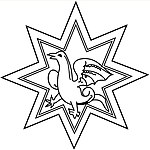Helen of Sweden (13th century)

| Swedish Royalty |
| House of Sverker |
|---|
 |
| Sverker I |
|
| Charles VII |
|
| Boleslaw, Kol |
| Sverker II |
|
| John I |
Helena Sverkersdotter of Sweden (c. 1190 – 1247) was a Swedish princess and abbess, daughter of King Sverker II of Sweden and the mother of Queen Catherine of Sweden. She was also the Abbess of Vreta Abbey.
Biography
Helena was born the daughter of King Sverker II and Benedikte Ebbesdotter. She was born in Denmark, where her father was an exile at that time. In 1195 or 1196, her father was crowned king of Sweden. In 1208, he was deposed, and in 1210, he died in battle.
Helena was the first of the three prominent victims of the Maid Abduction from Vreta, others being her daughter Benedikte Sunesdotter of Bjelbo and granddaughter Ingrid Svantepolksdotter. Helena Sverkersdotter, the only daughter of the deposed King, was educated at Vreta Abbey at the time of her father's death. Her relatives would not even hear the proposal of young Sune Folkason (d. 1247), son of an earl who had been among Sverker's opponents in the battle in which he himself fell. Sune Folkesson was of one of the two dynasties that had rivaled over the Swedish throne since 1130, and Helena was from the other, the Sverker dynasty. Sune Folkason abducted Helena and took her, according to folklore, to the castle of Ymseborg. They married, and two daughters survived from the marriage. Thus, the two Swedish dynasties was united, but only in a sideline.
In 1216, the brother of Helena became King John I. When he died childless in 1222, Helena and her daughters became heirs of the Sverker dynasty. One of her daughters, Catherine, was in 1243 married to King Eric XI, thus finally uniting the two Swedish dynasties.
Late in life, she is said to have become the Abbess of Vreta Abbey.
References
- Lars O. Lagerqvist (1982). "Sverige och dess regenter under 1.000 år",("Sweden and its regents under a 1000 years") (in Swedish). Albert Bonniers Förlag AB. ISBN 91-0-075007-7.
- Borænius, Magnus i Klostret i Vreta i Östergötland 1724 & 2003 s. 31
